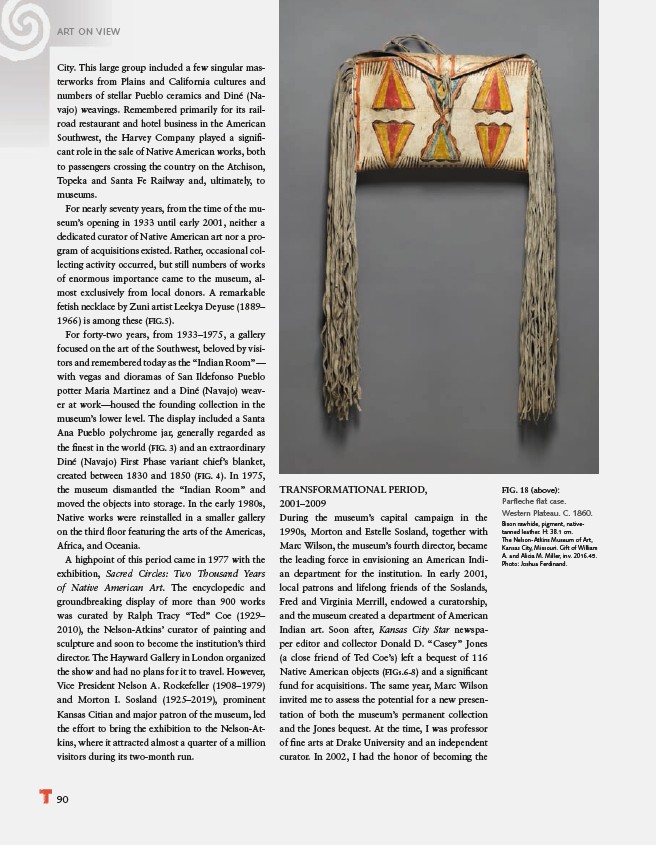
90
FIG. 18 (above):
Parfl eche fl at case.
Western Plateau. C. 1860.
Bison rawhide, pigment, nativetanned
leather. H: 38.1 cm.
The Nelson-Atkins Museum of Art,
Kansas City, Missouri. Gift of William
A. and Alicia M. Miller, inv. 2016.45.
Photo: Joshua Ferdinand.
TRANSFORMATIONAL PERIOD,
2001–2009
During the museum’s capital campaign in the
1990s, Morton and Estelle Sosland, together with
Marc Wilson, the museum’s fourth director, became
the leading force in envisioning an American Indian
department for the institution. In early 2001,
local patrons and lifelong friends of the Soslands,
Fred and Virginia Merrill, endowed a curatorship,
and the museum created a department of American
Indian art. Soon after, Kansas City Star newspaper
editor and collector Donald D. “Casey” Jones
(a close friend of Ted Coe’s) left a bequest of 116
Native American objects (FIGs.6-8) and a signifi cant
fund for acquisitions. The same year, Marc Wilson
invited me to assess the potential for a new presentation
of both the museum’s permanent collection
and the Jones bequest. At the time, I was professor
of fi ne arts at Drake University and an independent
curator. In 2002, I had the honor of becoming the
ART ON VIEW
City. This large group included a few singular masterworks
from Plains and California cultures and
numbers of stellar Pueblo ceramics and Diné (Navajo)
weavings. Remembered primarily for its railroad
restaurant and hotel business in the American
Southwest, the Harvey Company played a signifi -
cant role in the sale of Native American works, both
to passengers crossing the country on the Atchison,
Topeka and Santa Fe Railway and, ultimately, to
museums.
For nearly seventy years, from the time of the museum’s
opening in 1933 until early 2001, neither a
dedicated curator of Native American art nor a program
of acquisitions existed. Rather, occasional collecting
activity occurred, but still numbers of works
of enormous importance came to the museum, almost
exclusively from local donors. A remarkable
fetish necklace by Zuni artist Leekya Deyuse (1889–
1966) is among these (FIG.5).
For forty-two years, from 1933–1975, a gallery
focused on the art of the Southwest, beloved by visitors
and remembered today as the “Indian Room”—
with vegas and dioramas of San Ildefonso Pueblo
potter Maria Martinez and a Diné (Navajo) weaver
at work—housed the founding collection in the
museum’s lower level. The display included a Santa
Ana Pueblo polychrome jar, generally regarded as
the fi nest in the world (FIG. 3) and an extraordinary
Diné (Navajo) First Phase variant chief’s blanket,
created between 1830 and 1850 (FIG. 4). In 1975,
the museum dismantled the “Indian Room” and
moved the objects into storage. In the early 1980s,
Native works were reinstalled in a smaller gallery
on the third fl oor featuring the arts of the Americas,
Africa, and Oceania.
A highpoint of this period came in 1977 with the
exhibition, Sacred Circles: Two Thousand Years
of Native American Art. The encyclopedic and
groundbreaking display of more than 900 works
was curated by Ralph Tracy “Ted” Coe (1929–
2010), the Nelson-Atkins’ curator of painting and
sculpture and soon to become the institution’s third
director. The Hayward Gallery in London organized
the show and had no plans for it to travel. However,
Vice President Nelson A. Rockefeller (1908–1979)
and Morton I. Sosland (1925–2019), prominent
Kansas Citian and major patron of the museum, led
the effort to bring the exhibition to the Nelson-Atkins,
where it attracted almost a quarter of a million
visitors during its two-month run.